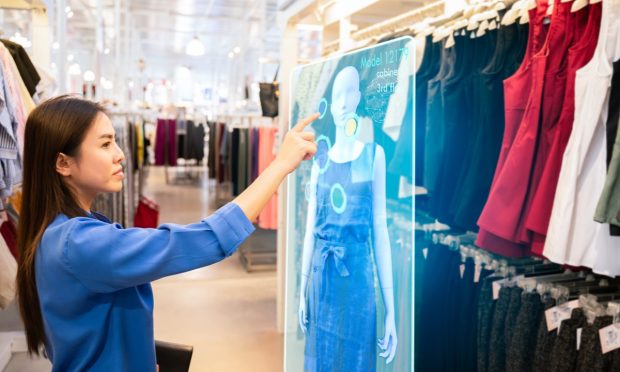Augmented Reality Helping Build ‘Store of the Future’

Scrolling through social media, it’s easy to see how widespread the use of augmented reality (AR) has become. What once was considered to be a piece of science fiction now allows teenagers, millennials and anyone else with a smartphone to try on glasses, shoes and make-up — or turn themselves (virtually) into a cat.
David Ripert, co-founder and CEO of Poplar Studio, told PYMNTS his company has found 75% of consumers expect retailers to offer some kind of AR experience. “Retailers today, if they want to be innovative and if they want to attract consumers back to their stores, they have to show that they adopt digital technologies as part of that consumer journey,” he said.
PYMNTS research has found that 55% of consumers are interested in trying new connected shopping experiences, whether shopping via AR, using smart mirrors in stores or shopping via voice assistant.

See: NEW DATA: How We Will Pay 2020: With Connected Devices, At Home And During The Week
Ripert said brands using Poplar Studio’s AR try-on feature saw conversion rates more than double as well as decreasing returns because consumers were able to determine whether, say, a refrigerator wouldn’t fit through the door or a television might be too small for a particular wall.
AR can also be utilized in-store, Ripert said, to show different variations of products without having to carry multiple models and take up precious stockroom space or to make shopping more interactive with scavenger hunts and virtual experiences.
“There are so many things that you can use AR for to make it more of a fun and innovative environment as a store itself,” Ripert said. “It’s helping reinvent the store of the future to make it not just a physical display store by something that people can play and engage with.”
With Facebook and other companies also starting to release smart glasses, Ripert said it’s only a matter of time before virtual overlays become commonplace, allowing companies to provide guidance to consumers as they roam store aisles or walk down the street.
Related: Facebook Launches Smart Glasses Line, Ray-Ban Stories
“It’s something retailers need to experiment with now and start to get ready for because it’s whoever starts first and builds these experiences that’s going to really bring that new generation of consumers into the store,” he said
Into the Metaverse
Ripert also noted that the rise of the metaverse, or immersive virtual worlds where people gather, work and socialize, also makes it crucial for retailers to adopt AR technology now so as to avoid getting left behind.
“A brand needs to be ready to deploy their products within those environments,” he said. “And right now, one of the obstacles is the availability of 3-D models, because brands have lived online in a 2-D format. … So that’s something that brands need to look at right now.”
In July, Facebook CEO Mark Zuckerberg told analysts and investors that he sees the metaverse as “the successor of the mobile internet … and the next chapter of us as a company.”
Read more: Facebook Highlights eCommerce, Metaverse Plans As Pressure On Ad Business Grows
“The defining quality of the metaverse is presence, which is this feeling that you’re really there with another person or in another place,” Zuckerberg said on a conference call. “Creation, avatars, and digital objects are going to be central to how we express ourselves, and this is going to lead to entirely new experiences and economic opportunities.”
For retailers, Ripert said, this means a growing overlap between the real world and its virtual counterparts; for brands offering exclusive items, this also means moving into the sale of nonfungible tokens (NFTs) and putting products on the blockchain.
“Consumers all want something that’s a bit unique to them,” Ripert said. “So, putting it on the blockchain as an NFT is something powerful because you have that sense of unique ownership as a consumer for a digital product. … and AR allows you to preview that product not just in a virtual environment but also in the real environment.”
Making AR Accessible
To be sure, many retailers are still working through an accelerated move to eCommerce, let alone adopting the ability to make sales in a virtual world, and creating 3-D models of products can be difficult on a budget. The traditional way, Ripert said, would be to ship a product to a studio to get volumetric capture using a dome of cameras that take hundreds of photos to create a 3-D asset.
Some software developers, however, have created mobile apps that help speed up the process and let brands create 3-D models on their own, with companies like Poplar Studio stepping in at the end to optimize the models and make them as realistic as possible. Poplar has a talent cloud of 2,000 modelers and creators, Ripert said, which helps “really scale 3-D model production.”
“And then it’s just education of those retailers and understanding what they need to do and how they launch AR try-ons onto their website,” he said.
